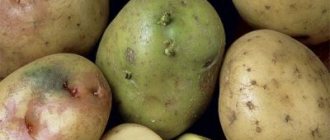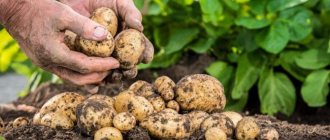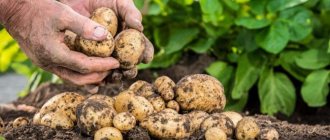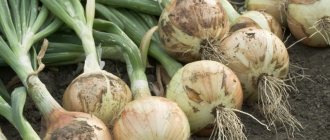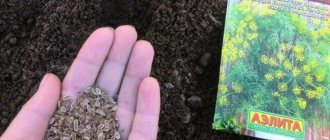Is it possible to wash potatoes before storing them?
There is no fundamental difference whether the potatoes were washed before winter storage or not. The main thing is that the products are dried and stored in optimal microclimatic conditions. Accordingly, each gardener decides independently whether it is necessary to wash potatoes after digging them out of the soil.
Did you know? Boiled potatoes are one of the few products allowed for consumption in the diet of patients with gastritis. Its consumption helps reduce acidity in the gastrointestinal tract.
Which potatoes last longer: washed or unwashed?
Opinions on this issue are divided. Some believe that washed potatoes last longer, others that less, since getting the skin wet disrupts the natural protective layer of the tuber. Therefore, there is no clear categorical answer to this question that worries many gardeners.
By the way, you can read our detailed article on the shelf life of potatoes.
Important!
One thing is important - regardless of whether the potatoes are washed or not, it is important to dry them well before storing them.
Some summer residents have been washing potatoes for several years and believe that this method allows them to be better preserved until the next harvest. During washing, rotten and diseased tubers that can infect the rest of the crop are necessarily eliminated, since the damage is better visible when clean.
But if the harvest is huge, then this method will not work, because washing and drying several tons of potatoes is a labor-intensive and costly process. However, the determining condition for storage is the humidity and air temperature of the room in which the vegetable is stored, and not the ideal cleanliness of the tubers.
Attention!
To preserve their nutritional properties, washed potatoes are stored in the dark.
Regardless of washing, only tubers that are healthy and not damaged by pests or shovels can be stored. And if you don’t wash the potatoes, this does not mean that they will be stored less than clean. Every summer resident is free to choose the most suitable option for himself.
Advantages and disadvantages of washed potatoes
To understand whether such a procedure is necessary, you need to adequately assess its pros and cons, and also understand whether you can create optimal conditions for high-quality drying of products.
- Benefits of potatoes washed after digging:
- improving the quality of product rejection - defects caused by mechanical damage, pests or diseases are better visible on washed peels;
- improving the presentation of tubers;
- making it easier to work with tubers in the kitchen - clean potatoes do not dirty your hands, they create less dust when storing them at home;
- elimination of fungal bacteria - water washes away most of the bacteria that are part of the soil microflora.
- The disadvantages of the technique are associated with the complexity of its implementation, especially if there are a lot of tubers:
- a fairly large amount of water will be required;
- a large area is required, which must provide drainage to remove excess water, high-quality ventilation and microclimate conditions for drying;
- Harvesting, washing and drying takes much longer than standard preparation for storage.
Based on the information above, washing potatoes before storage is justified only if the crop had to be dug up during the rainy season and there is too much dirt on it, or if the crop is very small. In other cases, standard treatment is sufficient, since the labor intensity and costs of water, as well as maintaining a large room with optimal microclimate conditions do not justify the goal.
Did you know? Potatoes are used not only in the food industry -
they are used to make glue and produce ethanol.
Is it permissible to store washed potatoes?
Is it possible to leave washed potatoes for the winter? Yes, you can, especially if it was dug up in rainy weather. However, it is important to thoroughly dry the tubers before storing.
The storage conditions are of decisive importance for the safety of the crop: optimal indicators are temperature from +2 to +4°C and humidity – 80-90%.
The best varieties for long-term storage
Not all varieties of potatoes are suitable for long-term storage. Late varieties are best stored.
Several varieties of potatoes with good keeping quality:
- Picasso - Dutch hybrid of medium late maturation. Potatoes reach physical maturity 140 days after planting. The table variety is characterized by high yield - 200–250 c/ha. The tubers are smooth, weigh on average 100 g. The pulp is cream-colored and boils well. The tubers have good taste. The keeping quality of tubers is 90%.
- Atlant - representative of the Belarusian selection. Tubers reach physical maturity in 120 days. The average weight of potatoes is 110 g. Productivity is 660 c/ha. The pulp is light yellow, very boiled. The variety is suitable for making purees and baking. It has high shelf life - 95%.
- Stonefly - Belarusian variety, ripening in 120 days. Productivity is 235-328 c/ha. In terms of use, the variety is universal, suitable for preparing any dishes requiring varying degrees of heat treatment. The weight of a commercial tuber is about 120 g. The pulp is light yellow, boils well, and has an excellent taste. Keeping quality is 94%.
- Slav - a variety of Ukrainian selection. Ripens in 120 days. The weight of tubers ranges from 90–250 g. Productivity is 200–300 c/ha. The pulp is creamy. Potatoes are suitable for preparing various dishes, including salads. Has good taste characteristics. Keeping quality is 95%.
- Kolobok - a table variety with good taste characteristics. The tubers are leveled, round in shape, weigh on average 130 g. Productivity is 130–250 c/ha. The pulp is yellow and boils well. Keeping quality - 98%.
How to wash potatoes
A bathtub or large pan can serve as a container for washing potato tubers. It is advisable that the container used for washing potatoes is not previously used for other household needs, especially for washing.
Then you need to pour the potatoes into the bath and fill it with water at room temperature. Each potato tuber is thoroughly washed without disturbing the integrity of the peel. During the washing process, injured and diseased potatoes are rejected. In addition, at this stage you can sort the tubers - large ones for eating and small ones - for planting next year.
If you wash potatoes in a container, you need to change the water several times until it becomes clear. Or, as an option, you can wash the potato tubers under running water. On a pre-prepared surface, you need to lay out the washed vegetables in one or maximum two layers. A metal sheet, boards, polyethylene or fabric can serve as a substrate for drying potatoes on the ground. The point is that the tubers do not come into contact with damp soil.
If the weather is hot, then 3 hours will be enough to dry the tubers. In this case, you need to turn the potatoes at least three times. In cooler temperatures it may take up to 8 hours to dry. There is no specific time, it is important that the potatoes become dry. Then it can be folded into boxes and taken to a dark place.
After 10–14 days, tuber culling should be repeated. After this, the dry and washed potatoes can be taken to the cellar. It is better to store potato tubers in wooden boxes or bags made of natural burlap.
How to properly prepare potatoes for storage
After the crop is dug up, it is left for several hours right next to the beds.
Then sorting is carried out, laying out separately:
- tubers for seeds - small specimens of the same size;
- damaged copies;
- tubers for long-term storage.
Seed potatoes are left for several days in a well-lit place for gardening, then placed in separate boxes and sent for storage.
Damaged tubers are left for food and livestock feed. These copies need to be used up as quickly as possible.
Did you know? Potato starch is used to create detergents that clean oil wells.
Potatoes intended for long-term storage undergo the following stages of preparation:
- sorting by size - small ones are stored less than large ones, and more voids are formed between potatoes of the same size, which provides better ventilation and reduces the risk of rotting;
- drying in a dark room with good ventilation for a week;
- re-sorting with rejection of low-quality, deformed specimens and removal of excess dirt.
After all the preparatory measures, the harvest can be sent for storage.
How to store potatoes. How and where to store potatoes in an apartment
Planting, growing and harvesting potatoes is not all the tasks facing a summer resident. We must try to preserve the harvest until the new season, and special attention should be paid to tubers intended for future sowing.
If you have harvested potatoes and don’t know how to store them in your apartment, our article will help you cope with this problem. We will tell you where and how to properly store potatoes in an apartment, and photos and drawings of cellars and drawers will help preserve vegetables until the next harvest.
How and where to store potatoes in an apartment
For winter storage, healthy tubers are selected, without any damage. It is collected in dry weather and left in the open air for several hours, after which it is collected.
Note: If drying in the open air cannot be done, the tubers are laid out indoors for 2-3 days to dry, constantly ventilating the room.
After drying, the crop is sorted again, putting aside vegetables with mechanical damage.
To prevent the crop from rotting, you must adhere to certain conditions:
- The room should be well ventilated to slow down the process of starch breakdown.
- The air temperature should be 5°C, for a short period 7-10°C. At temperatures below 5°C, starch turns into sugar, which leads to a change and deterioration in taste characteristics.
- Vegetables can also be stored in a refrigerator drawer, but a few days before use, move it to a warm place so that the sugar turns into starch.
Figure 1. Options for placing the crop at home
If all rules are followed, the crop can be stored for up to 6 months, but at home this period is usually only a few weeks. Figure 1 shows the main options for the location of potatoes in the cellar and at home.
General recommendations
After harvesting, the tubers are heated in the sun to separate the soil from the tubers, then sorted. In the first weeks after harvesting, there is a treatment and prophylactic period, during which diseases appear and lesions during digging are healed. Suberin appears on damaged areas, which prevents pathogens from penetrating inside. Preparing the crop for storage in the cellar is shown in Figure 2.
Optimal storage conditions for potatoes
To preserve the presentation and taste, it is necessary to create special microclimate conditions:
- lack of light entering the room;
- temperature - +4...+6°С;
- humidity - 75–80%.
To control the temperature in the room, there must be a thermometer. You should also take care of the presence of a ventilation system.
When and how to dig up potatoes for storage
Any gardener wants to get a good potato harvest that will be stored for a long time. And for this it is necessary for the tubers to fully ripen, gain the necessary weight and accumulate useful substances.
How to determine the exact date of excavation?
In the middle zone, potatoes are usually harvested from the end of August to the first ten days of September. But these terms are very variable, since the ripening period of potato tubers largely depends on the timing of planting, variety, weather conditions, as well as care characteristics.
What to focus on then? On the appearance of the tops. This is the most obvious sign that will tell you whether the potatoes are ready for harvesting or not. If the tops begin to die and dry out, the tubers are ripe. Potatoes can be dug up within 3 weeks after the above-ground parts have withered. It is not worth keeping the crop in the soil, otherwise it will not be stored well.
How to dig up potatoes correctly?
It depends on the soil in which it grows. If the soil is loose, then simply pull the tops and the tubers will appear on the surface. All that remains is to collect them and use a shovel or pitchfork to check whether the remaining potatoes are lost deeper in the ground.
On dense soil, bushes should be dug up from the side. This can be done with a pitchfork or shovel. Each of the tools has its own advantages and disadvantages. It is easier to dig up a whole “nest” of tubers with a pitchfork without damaging the crop. But if a pitchfork pierces a potato, then such specimens will not be stored for long. When using a shovel, the risk of damaging the tubers increases. However, cuts from a shovel quickly weather out in the air, and such potatoes can lie in the cellar for some time.
Potato storage methods
There are several ways to store potatoes, depending on which the shelf life of the crop will change.
In the cellar or basement
Basements are an ideal option for storing crops. In such conditions it can be stored in boxes or bags. To absorb excess moisture, the products are laid out in layers of straw and sawdust. To protect against pests and bacteria, herbs are placed in bags and boxes. Tubers can also be hung at a low height in nets if the room maintains a stable temperature throughout the winter.
Important! The only vegetable that can be stored in close proximity to potatoes is beets. It has the ability to absorb excess moisture released by potatoes.
In the basement it is important to provide reliable protection from frost. If in winter the temperature drops significantly, then the containers with products are wrapped in old rags. Heaters are connected if necessary.
Before storing in a cellar or basement, it is imperative to completely disinfect the walls, floor and ceiling. To do this, you can use slaked lime or a 3% solution of copper sulfate. Treatment is carried out 2 weeks before moving the crop for storage. After disinfection, you need to ventilate the room well and dry the walls thoroughly.
In the apartment - on the balcony or loggia
At home, the harvest can be stored on the balcony or loggia. In this case, the period of use of the product is reduced by at least a month, depending on climatic conditions. On an unglazed balcony/loggia, tubers may suffer from frost. To protect containers with products, they wrap them in cotton blankets, but this does not always save the situation. You can also use electric lamps or a hairdryer. These methods will help protect the crop if frosts last no more than 2-3 days, and then a thaw sets in; they are not effective during prolonged cold spells.
The box for storing the harvest on the balcony/loggia must be double-layered. To do this, select 2 containers of different sizes and place the smaller one in the larger one. The gap between the boxes is filled with sawdust or straw. After laying the product, the container is wrapped in a cotton blanket and placed on a hill, for example, a stool or tray.
Read more about how to properly and what is the best way to store potatoes on the balcony.
In the hole
A good option for storing tubers in pits. But it is only suitable for preserving a small amount of produce that is planned to be used in the spring. Another disadvantage is that the product is not protected from rodents.
To store this way you need:
- Dig a 1x1 m trench of arbitrary length on a hill that will not be flooded when there is a lot of precipitation and snow melts in the spring.
- Cover the tubers with a layer of 80 cm before the onset of frost.
- Fill the remaining space in the hole with straw, branches or pine needles.
- At the first frost, form a mound of soil 30 cm high.
When the snow melts, the products can be dug up and eaten or used for planting.
How to store washed potatoes: optimal conditions
Store washed potatoes for the winter in the same conditions as unwashed ones. The maximum storage time for the crop is observed when the temperature is from +2 to +4°C and the air humidity is 80-90%.
As the temperature rises, the potatoes begin to sprout and become flabby. Harmful substances accumulate in the vegetable, and it can no longer be eaten.
When exposed to negative temperatures or stored at 0°C, the starch in the tubers is converted to sugar, and the vegetable acquires a sweetish taste. However, short-term exposure to low negative temperatures does not lead to such consequences.
In the cellar or basement
A cellar or basement is suitable for storing potatoes. Before planting vegetables, the room is cleared of remnants of last year’s harvest, dried, ventilated, and disinfected. For disinfection, use a solution of lime, copper sulfate or sulfur bomb.
Wooden boxes and boxes for storing vegetables, as well as flooring and shelving, are treated with a solution of potassium permanganate and thoroughly dried in the sun.
Attention! The cellar or basement must have good thermal insulation to protect food from frost and elevated temperatures.
On the balcony or loggia
In urban conditions, potatoes are stored on balconies and loggias. It is convenient to use wooden boxes insulated with materials with waterproofing properties for these purposes.
You can make such a box yourself from wooden boards or thick plywood. The best option is two boxes of different sizes, inserted one into the other. The void between them is filled with foam plastic, dry sawdust or other suitable material.
If you have neither the time nor the desire to build a box yourself, purchase a ready-made thermal container for the balcony. There are boxes and bags on sale with thermostats in which vegetables can be successfully stored at -40°C.
Why potatoes are poorly stored: possible mistakes
Products can deteriorate during storage for many reasons:
- excessive application of nitrogenous fertilizers during the growing period;
- poor drying after digging;
- neglect of the rules for disinfecting premises before storing products;
- poor-quality potato sorting;
- lack of sufficient ventilation in the room;
- non-compliance with the rules of food proximity - when stored next to other vegetables, potatoes spoil much faster;
- excess or lack of moisture in the room.
Important! During storage under any conditions, it is necessary to periodically
cull diseased tubers, otherwise all the potatoes will become infected and the shelf life of the crop will be significantly reduced.
Before storing, it does not matter whether the potatoes have been washed or not. The main task of the farmer is to dry the crop well and create optimal microclimate conditions.
Common mistakes when storing potatoes
We list the most common mistakes that lead to spoilage of vegetables stored for storage:
- Wrong choice of variety for storage in the cellar. Only late and mid-season ones are planted for the winter. They will last until spring without loss. Early ripening potatoes will last until November at best, even under ideal conditions.
- Storing undried potatoes. If you put wet vegetables in the cellar, this will inevitably lead to the rapid appearance of rot and damage to the crop.
- Laying tubers of poor quality. Only healthy and undamaged potatoes will be stored for a long time. When sorting, specimens with the slightest signs of rot, scratches, or cuts are mercilessly removed.
- Storing tubers in large piles. It is better to arrange vegetables in small boxes, boxes or bags. This makes it more convenient to use them and periodically go through them.
- Storage in the same container with other vegetables. You can only keep beets in one box or bag of potatoes. It is laid out on top to absorb excess moisture.
- Temperature violation. Air temperatures above +4°C or below +2°C have a bad effect on keeping quality. In the first case, the vegetables become flabby and sprout; in the second, they freeze slightly.
- Neglecting periodic inspections of vegetables in storage. By inspecting your supplies from time to time, it is easy to notice spoiled potatoes in time and remove them from the general pile.
By avoiding these mistakes, you will ensure the safety of vegetables until spring.
How to treat potatoes before storage
Before sending for storage, tubers can be treated with a solution of copper sulfate - this way they will be stored better. 2 g of the drug should be dissolved in 10 liters of water. You need to spray the fruits well with the product and let them dry.
A herbal infusion will help prevent rot from occurring. For 10 liters of water, take 1.5 kg of wormwood, 3.5 kg of wormwood and 750 g of tobacco leaves, leave for 24 hours. This infusion can be sprayed on the potato crop, using about 100 ml per 25 kg of tubers.
By the way, wormwood and wormwood, as well as other phytoncidal plants, can protect potatoes from rotting, even if their leaves are simply spread between the tubers. This is done in such a way that for every 50 kg of potato harvest there is about 0.5-1 kg of grass.


